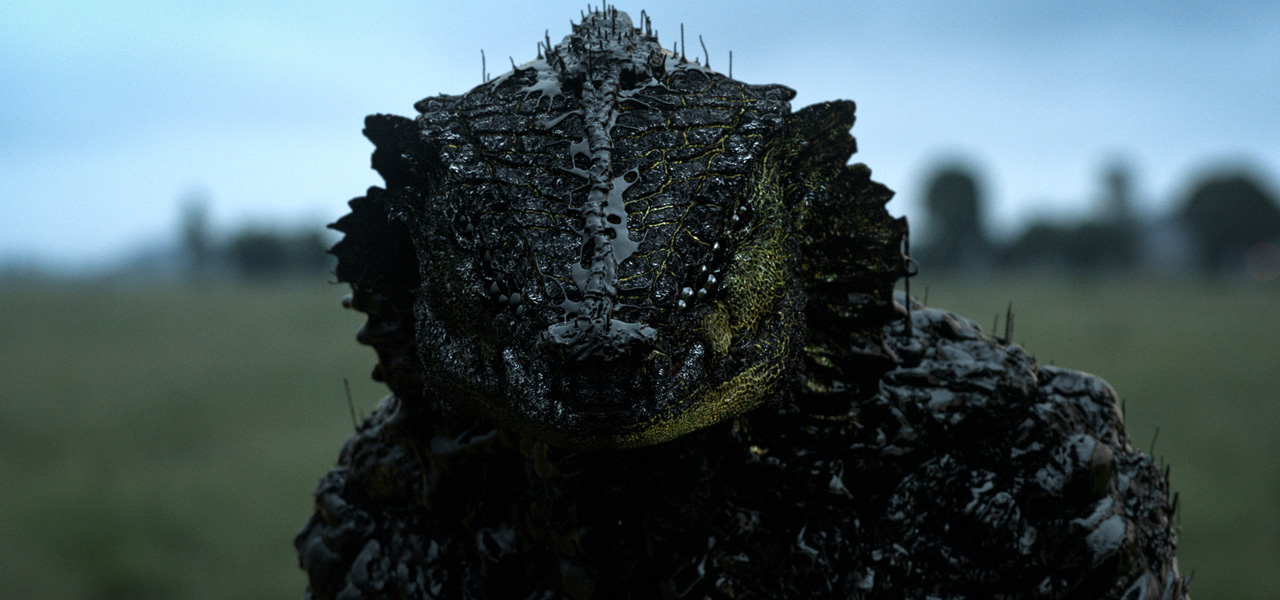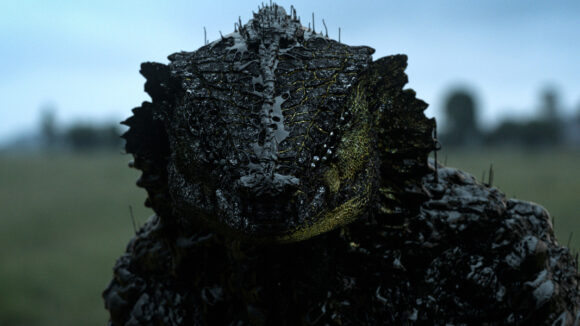

Inside Neill Blomkamp’s First Experimental Oats Studios Short ‘Rakka’
When Neill Blomkamp recently teased a series of experimental shorts online, the word quickly spread. The shorts are from the director’s new Vancouver-based Oats Studios, and visual effects and animation play a major part in the venture.
Of course, before he directed District 9, Elysium, and Chappie, Blomkamp made a name generating dystopian film pieces, such as Alive in Joburg. These remain held in extremely high regard, which is why the prospect of more of these independently-made projects caused such buzz.
The first Oats Studios experiment, Rakka, has now been released. It’s a 20 minute sci-fi short in which lizard-like aliens have invaded Earth and begun experimenting on humans (and it just happens to feature actress Sigourney Weaver). Oats visual effects supervisor Chris Harvey, who worked with Blomkamp on Chappie, took Cartoon Brew through the making of the short and the making of an experimental studio.
Realizing Rakka
Harvey describes Rakka as “a picture into a world” that introduces you to the character and what’s going on, but only scratches the surface of the larger story. That story is the arrival of an alien civilization – called the Kluum – which partially takes over cities and experiment on humans. The short focuses, too, on the resistance against the lizard invaders.
As a new independent studio, Oats had budget pressures in making Rakka and the other shorts to come. Harvey notes though that those restrictions actually brought on the need for more careful planning. “In some ways, I think big budget feature films sometimes suffer from honestly not having to worry about money enough, or maybe worrying about it the wrong way.”

“If the weather is bad, there’s no weather day,” added Harvey, who noted Rakka was filmed in just five days. “For example, in that scene where they are chasing the alien, that was shot over two days and the weather was completely different both those days. One day it was raining and the other day was sunny. And we were really ambitious in the whole shoot – we were blowing up trucks and filming with high speed Phantom cameras, and we were moving pretty quick. Neill shoots fast but this was a whole other level of that.”
It was shot in South Africa, and, with a significant number of visual effects shots, largely followed a typical process for acquiring plates, and measuring and scanning sets. “We rely on photogrammetry a lot,” said Harvey. “That’s a big part of our process in terms of set surveying, and that’s how we cyber scan everybody.”

The alien in Rakka is completely digital, but on set a practical head designed by well-known creature effects supervisor Alec Gillis from Amalgamated Dynamics (ADI) was used for reference (Gillis also has a cameo in the final film). In addition, a costume piece for the arms was used, and practical pants were worn for some scenes by Blomkamp’s brother, Mike. Like Blomkamp’s other films featuring cg robots, performers wore gray tracking suits as stand-ins in for the aliens.
The final digital creature design was produced by Oats creature modeler Ian Spriggs, who relied on a mix of reference from turtles to alligators. One of the alien’s signature elements is a black liquid nanotechnology – something Oats called ‘swax.’ “The concept behind it,” explained Harvey, “is they’ve got a gazillion gallons of this black technology and that’s the basis for everything. That’s their vehicles, it’s their building, their structures, it’s their armor that they wear, it’s their weapons, and it’s thought-controlled. It will take the shape of whatever they need it to take shape and do.”

Effects artist Alex Lombardi developed a fluid simulation in Houdini to deal with the moving black liquid and have it flare up and down. That would then be deformed by tools written by Lombardi and pipeline/rigger technical director Eric Legare, meaning it could be bound to the final animated character. The same liquid is seen in much more grand vistas, too, overtaking buildings and even whole landscapes.
Another signature effect in Rakka is the alien augmentation of the character Amir, in which a combination of cybernetic additions have been added to his head, including the black liquid. The actor was filmed with a prosthetic head cap and practical metal pieces. It was not intended to be anything further than those practical additions, until an artist at Oats suggested adding in something moving that resembled the swax the studio had been working on elsewhere.

“Neill was like, ‘That’s a great idea. Let’s do it,’” recalled Harvey. “I was like, ‘That’s awesome, but now we have a bunch of new shots and we’ve got to do a head track.’ I said to Sean, the artist who suggested it, ‘Neill likes your idea; we’re going to put it in the film so guess what you get to do for the next few weeks?’ He spent the next couple of weeks just R&Ding, coming up with a way to do it.”
“It actually comes back to something Neill is doing here, which is he wants honest feedback,” added Harvey. “He doesn’t want it to be just like, ‘Yeah, it’s cool, Neill.’ He wants to know, do you really like it, what didn’t you like about it, what isn’t working? Everyone’s got a creative voice right from the very beginning to the point where people feel like they’re making creative impacts on these stories, as opposed to just being an artist for hire, which is often more the feeling.”

The Oats philosophy
With its signature Blomkamp style, Rakka is of course designed to showcase what Oats is capable of. And that, according to Harvey, is as an outfit deliberately outside the typical studio system. “Everything is independent so we’re not beholden to anyone else other than ourselves, in terms of creativity. We’re accountable to each other and to ourselves rather than to a third party. That changes the mindset of everything.”
Being under one roof in Vancouver also provides what the filmmakers at Oats consider a ‘clear creative path,’ away from what might traditionally be a long line of supervisors and producers through to the director. “Neill is available here so we can just ask him,” said Harvey. “We walk over to people’s desks and we talk to them. It’s not even just with interaction with Neill, but it’s interaction with all the departments.”

At its facility, Oats Studios is indeed a mix of concept and design artists, production staff, and practical effects and digital effects teams. Not all of the experimental projects – which will be released on an ongoing basis – are as heavy in effects as Rakka. Some are around the 20-minute length, while others are very short, just a hint of an idea.
Ultimately, the goal of the studio is to test the waters, to see if an audience likes an idea that could then be taken further. Blomkamp has stated that he would like a short to be turned into a feature film, an intention backed up by Harvey. “It’s about getting the audience more involved in what we’re doing, with the end goal of outputting as many stories as we can, as shorts, and probably most of those being free. And then with every few batches of shorts, we would take one of those that resonated the most with us and the most with the audience and say, ‘Let’s make a whole feature and release it in theaters.’”
Since the goal is to get these shorts out there for audiences to see, Oats is aiming to produce high quality but not worry too much about the details. “We like to ask, ‘Do we always need to do the last five per cent?’” said Harvey. “In feature films we iterate forever for that last five per cent. Just because that’s what we’re expected to do. At the end of the day, if you have a good story, most of the audience is going to be okay with 95 per cent [especially] if it allows us to do twice the volume of work and get twice as many ideas out there.”
In staffing up on the visual effects side for Oats, Harvey looked to people he had previously worked with who were advanced in their skill level, but could also take on multiple roles in a small facility. The visual effects supervisor even says that “many of our artists have come to me and said, ‘Man, you’ve totally ruined us, we can never go back to the real world because it’s just so much fun here.’”
So much fun, in fact, that Oats has instituted something borrowed from Silicon Valley tech companies called ‘Creative Fridays.’ Artists work Monday to Thursday, but then are able to work on whatever they like on Friday. The result, says Harvey, was actually an increase in productivity because artists felt a strong association with the independent ‘vibe’ of the studio.
“Everyone here just seems to catch the vibe that we are trying to do something different, we’re trying to do something fresh and new, not just in terms of content, but also in terms of the process behind making the content.”
